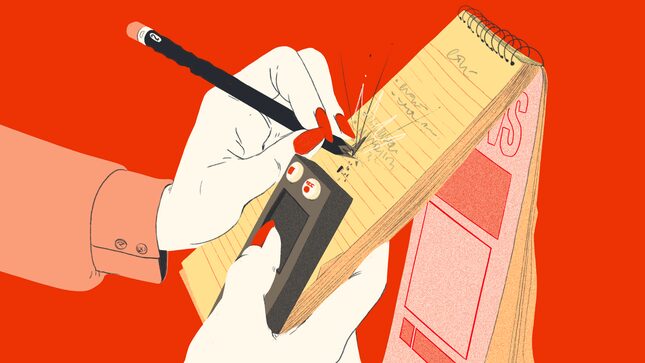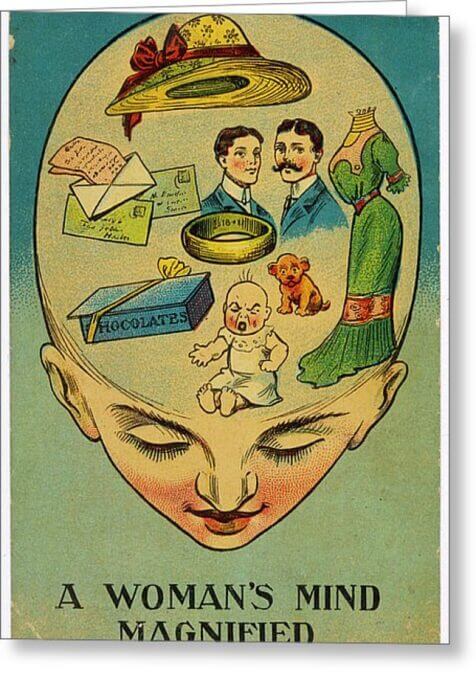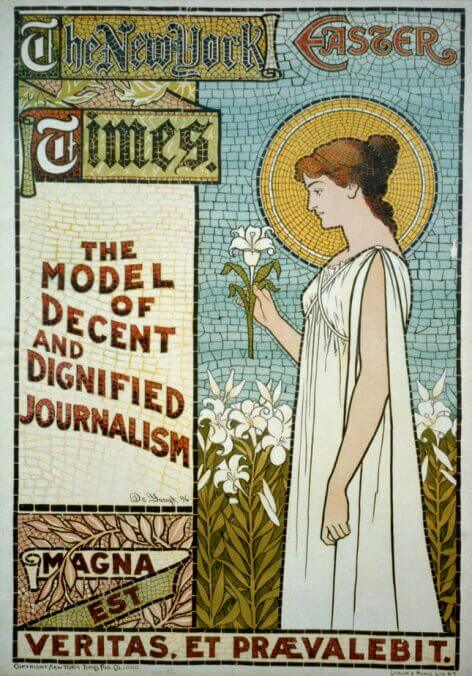
Image: Chelsea Beck/GMG
The stereotype of the incompetent, irrational woman journalist is resurgent. She is familiar and she’s bad news: she’s volatile, unethical, and not very good at her job, and she discredits anyone with a feminine-leaning identity who works for the press. Though we know by now she’s an illusion, a hoary trope in a similar vein to the Manic Pixie, she persists.
It’s hard to miss her on television. In House of Cards, journalist Zoe Barnes was often out of her depth, pulled there by her own ambition. Clever but unwise in where she placed her trust, she wound up with that frequent fate of women journalists in fiction: an affair with her most important source, followed by a gruesome death. In the original British series of House of Cards, Barnes’s equivalent was reporter Mattie Storin, who kept a writhing bundle of complexes barely contained beneath her demure, floppy-collared work suits (she referred to her much older, MP lover as “Daddy”). She, too, ends up killed off. And in HBO’s adaptation of the Gillian Flynn novel Sharp Objects, the beautiful, scarred Camille Preaker drifts into eddies of compulsion and booze as she reports on murders in her hometown.
The type pops up in literary fiction, too; the protagonist of Jonathan Lethem’s recent novel The Feral Detective describes her role at the office—in her case, the New York Times: “I’d been a decorative editorial flunky, a limit I’d never fought my way free of. (That was partly my fault, hey—it wasn’t as if I’d gone around pitching brilliant ideas for op-eds, and the witticisms that turned the heads of the men around me were more in the cause of charming self-deprecation than of carving my way out of the category of the highly dateable.)”
This enduring character type is dangerous because plenty of people believe she is real. Some of them wield global power. In a press conference on October 1, 2018, the President dismissed three reporters, all of them women. “She’s not thinking! She never does,” he was heard to tell ABC White House correspondent Cecilia Vega, before wagging his finger at CNN’s Kaitlan Collins and cutting off a third who asked a question about mass shootings. “I watch you a lot, you ask a lot of stupid questions,” he told CNN’s Abby Phillip at a press conference a few weeks later. That sentence alone could stand for how audiences as a whole have come to look at women reporters: fun to watch, ripe for tearing down. The problem has been ably dissected with an eye to what’s happening now.
The madwoman in the newsroom was first invented over a century ago. Ever since women entered the field of journalism in meaningful numbers, she had an unreliable counterpart in fiction. Leading the brigade, in The Portrait of a Lady (1881), Henry James sketched the comic character of Henrietta Stackpole, a reporter for the New York Interviewer. She is a nonconformist who hectors her friends to get married while insisting that she herself does not need a man to be happy (though ultimately, she marries). James himself admitted to Miss Stackpole’s “slightness of cohesion,” writing in his preface to the 1908 edition, “Henrietta must have been at that time a part of my wonderful notion of the lively.” In the 1908 edition, James describes Miss Stackpole as “smell[ing] of the Future—it almost knocks you down!” She isn’t a person so much as a symbol of a changing society, written by an ambivalent author who wanted to make her a figure of fun.
Like the insouciant Gibson Girls on bicycles who coasted across magazine covers in the Progressive Era, Miss Stackpole signaled new freedoms that were opening to women. For most of the 19th century, if educated, unmarried, ambitious “New Women” chose to work outside the home, they were expected to heed a call to a pious or caretaking vocation: missionary work or teaching. Writing and the press were less conventional options for those who weren’t drawn to these two paths, but women could and did write for the press—mostly from home, mailing in their pieces on housekeeping, fashion, and family life to editors. That changed with the groundbreaking careers of outliers including Sarah Josepha Hale, formidable editor of the required-reading magazine Godey’s Lady’s Book; transcendentalist critic Margaret Fuller; reporter Nellie Bly, famed for her undercover work; journalist and civil rights leader Ida B. Wells; and investigative magazine writer Ida M. Tarbell.

By the turn of the 20th century, journalism was decidedly co-ed. “These modern days are certainly the opportunity of the Women,” wrote English writer Ella Hepworth Dixon. “For the first time they can, and do, compete with men… One of the last citadels to fall was the newspaper office. Here prejudice reigned supreme […] Today the Bastille of Journalism has fallen.”
The reaction in fiction was swift. At best, it was anxious and picaresque, like James’s Miss Stackpole. At the other end of the spectrum, newswomen saw their careers overshadowed by affairs of the heart.
A typical narrative—part exhilarated, part cautionary—was the novel A Daughter of To-Day by Sara Jeannette Duncan (1894). Duncan, herself an intrepid Canadian newspaper columnist, tells the story of striking, unconventional Elfrida Bell (whose name and early career recall Tarbell’s), a daughter of deadly-wholesome Sparta, Illinois, who moves to Paris and takes up journalism. Her insistence that her work has intrinsic value is, in the world of the novel, a sign of delusion, and a prelude to losing her heart (and everything else) entirely. Duncan writes of Elfrida’s first flush of feeling toward the man who eventually drives her to suicide:
Elfrida felt the keenest pleasure of her whole life in the knowledge that Kendal was talking to her more seriously, more carefully, because of that piece of work in the Decade; the consciousness of it was like wine to her, freeing her thoughts and her lips. Kendal felt, too, that the plane of their relations was somehow altered. He was not sure that he liked the alteration. Already she had grown less amusing, and the real camaraderie which she constantly suggested her desire for he could not, at the bottom of his heart, truly tolerate with a woman.
It takes 200 pages, but Elfrida gradually sees that her man will never love her in return—in fact, he thinks her ambition is grotesque—and that her work is no consolation. Rage washes over her. She thinks, “He will marry some red-and-white cow of an Englishwoman who will accept herself in the light of a reproductive agent,” and takes poison.
Occasionally, the fate of the newswoman is not death but a kind of rotten security gained at the expense of a more deserving man. “A Lady Journalist,” a short story by George Paston— the pen name of Emily Morse Symonds—follows Evelyn, who brazens herself onto the staff of the Reader. She can’t or won’t write her own articles, however, and cajoles her fiancé to do the work for her. Hoping that “Evelyn would very soon tire of this journalistic fancy,” he agrees. But “Evelyn did not tire of her journalistic freak,” and he is soon so overwhelmed that he is fired from the staff of the same magazine and has a nervous breakdown. On the last page, Evelyn leaves him a letter saying she has left him and married the editor of the Reader.
In Jennie Baxter, Journalist by Robert Barr (1898), the story is less biting, but the central character just as unserious. The eponymous heroine proves herself to a curmudgeonly editor; solves a mystery about a princess’s vanishing diamonds; goes undercover at a ball and wins the heart of a Lord, and ends by marrying him and resigning from the paper. Her career is the caprice of someone too young to know what she wants.
Op-eds and columns focused on the women journalist—written by women and men alike—warned that finer sensibilities and fulfilling relationships would fall by the wayside if they stayed in the field too long. In “The Confessions of a Newspaper Woman” (The Atlantic, 1905), Helen M. Winslow looks back with regret on the effect her career had on her soul:
I have attended an all-day convention, and worked far into the night, writing reports for messenger boys to take in sections “red hot” to the presses… I have worked eight hours a day in my dark, dingy office, and six more in my “den” at home every night… The life is too hard and too hardening. Women are not fitted for the rush-at-all-hours a reporter’s life demands. There will be a chance for them as editorial, fashion, household, society, and critical writers.
In order to keep up with the rigors of the journalist’s life, Winslow seems to be saying that women need to trade in a goodly helping of sanity. After throwing herself into the hustle of city newspapers, she compares herself to a “squeezed lemon,” bereft of creativity and spirit.
By 1898, the woman reporter had become mainstream enough that Journalism for Women: A Practical Guide appeared on the market. The author, English novelist and self-help writer Arnold Bennett, was just then working as assistant editor on the magazine Woman. He was unapologetic about stating the frailties of his colleagues of the opposite sex. The female journalist is born with faults, Bennett instructs, which are “traceable either to an imperfect development of the sense of order, or to a certain lack of self-control.”

These boil down to three major traits: women reporters are unreliable, inattentive to detail, and have an embarrassing lack of restraint. In the world of journalism, he wrote, there were “… not two sexes, but two species—journalists and women-journalists—and that the one is about as far removed organically from the other as a dog from a cat.” Recent scientific studies bolstered Bennett’s case. A Popular Science article on “Mental Differences of Men and Women” (1887) by evolutionary biologist George Romanes demonstrated that women had less brainpower than men, seeing as their brains were on average five ounces lighter. “[On] merely anatomical grounds,” the reader is told, “we should be prepared to expect a marked inferiority of intellectual power in the former.”
Taking a broader view of how journalists, in general, are portrayed around us, it is true that they are often painted as volatile, regardless of gender. Even in the Gilded Age, journalism was seen by many as morally suspect; only a damaged or predatory person would dedicate themselves to it. The rivalry between “Yellow Journalist” newspapermen Joseph Pulitzer and William Randolph Hearst fueled a rise in sensation-seeking, favoring writers who could engineer press-worthy stunts and report with more of an eye to sales than factuality. Much later, Janet Malcolm precisely articulated the problem that plagues even honest reporters in The Journalist and the Murderer (1990): “Every journalist who is not too stupid or full of himself to notice what is going on knows that what he does is morally indefensible. He is a kind of confidence man, preying on people’s vanity, ignorance, or loneliness, gaining their trust and betraying them without remorse.” This negative view only bolsters the staying power of the morally unsound woman journalist: it allows those who believe it to say, she is rotten because they all are.
Each aspiring Murphy Brown is joining an odd sisterhood, one where Henrietta Stackpole rubs shoulders with Lois Lane and Miranda Priestley. Today the best-known examples come from film and television, but it’s a group that has been growing and solidifying for centuries. In most cases, she doesn’t survive the newsroom. “That’s why I’m quitting,” says Hildy Johnson, the gifted heroine of Howard Hawks’s His Girl Friday; “I want to go someplace where I can be a woman.”
It would be losing proposition to try and correct this feedback loop between bias and pop culture by restricting portrayals of reporters in fiction to conscientious, upright members of society. No one watches House of Cards for moral edification; in contrast, while Spotlight gave a terrific insight into how great investigative stories come about (drudgery, frustration, stumbling), the reporters turned out to be unmemorable characters. But it is equally a mistake to ignore the long tradition of treating women in the fictional newsroom as ditzy or villainous interlopers.
As with any process of recovery, the first step of addressing the persistence of this stereotype is to recognize the problem. Women journalists are not especially prone to incompetence and sleaze, any more than the press is the enemy of the people.
Stephanie Gorton is a writer and editor in Providence, RI. Her book about Gilded Age journalists is forthcoming from Ecco/HarperCollins in 2020.